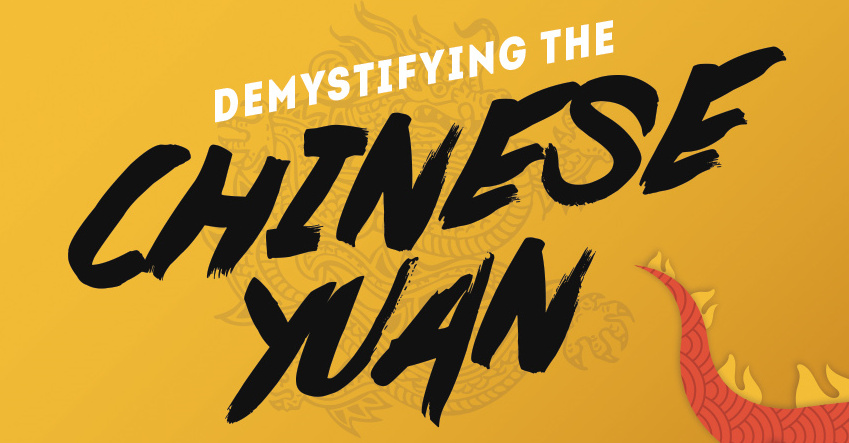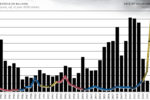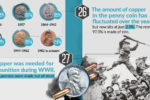
Demystifying the Chinese Yuan
The Money Project is an ongoing collaboration between Visual Capitalist and Texas Precious Metals that seeks to use intuitive visualizations to explore the origins, nature, and use of money.
With one of the world’s largest economies and a growing financial sector, China continues to rise as a global power.
The country’s currency, the Chinese yuan (officially the Renminbi), is also starting to mature. The most recent evidence of this? The IMF’s decision to include the yuan as a part of its SDR international reserve asset, a basket of major world currencies:
| Currency | 2011-2015 SDR | 2016 SDR | Change |
|---|---|---|---|
| U.S. Dollar | 41.9% | 41.7% | -0.2% |
| Euro | 37.4% | 30.9% | -6.5% |
| Pound | 11.3% | 8.1% | -3.2% |
| Yen | 9.4% | 8.3% | -1.1% |
| Yuan | 0.0% | 10.9% | +10.9% |
The Chinese economy is significant on a world stage, but its currency and financial system still have major growing up to do.
China is walking a fine balance: it desperately wants to legitimize its currency, but it also must find ways to keep its economic engine moving forward.
The Yuan’s Wild Ride So Far
In the early 1980s, the Chinese began to implement ‘Socialism with Chinese characteristics’, by opening up the state-controlled economy to the global market in very limited ways.
Since being on the world stage, the yuan has been all over the place. It’s been pegged to the U.S. dollar, unpegged, and then temporarily re-pegged again during the Financial Crisis.
Most recently, the currency was devalued sharply in 2015 to make up for slowing GDP growth. Today, it sits at six-year lows against the U.S. dollar.
The PBOC and the Chinese Yuan
The strategy used by The People’s Bank of China has not been easy to follow.
China wants its currency to matter, but it is also guilty of intervening in currency markets according to the priorities of the day.
In September 2016, for example, the country increased overnight borrowing rates and bought up the yuan in large amounts to counteract shorting from international traders.
The Fix Is In
Onshore, the yuan is allowed to trade within 2% of the PBOC reference point.
The previous day’s trading might be a factor in setting this. Then again, it may not matter. The decision is not up to the market. Value is set by unnamed officials behind the scenes.
This “flexibility” allows China to swing between different strategies for the yuan.
The Dragon’s Gambit
China can print money endlessly to keep the yuan’s value artificially low, which is good for manufacturers. This is handy in a case such as when exports fall year-over-year, and the economy is slowing.
But in other cases, China has different priorities, such as protecting the value of the yuan during times of international uncertainty. It can help to do this by securing the yuan with surprise gold holdings announcements or by dumping massive amounts of U.S. Treasuries to prop up the yuan’s price.
Sometimes these divergent strategies appear to be operating in the same week. Who’s in charge?
International currency traders ultimately don’t know how these decisions are made, or who is making them.
The Golden Hoard That Wasn’t
China’s currency manipulation has helped it to accumulate massive foreign exchange holdings. But these holdings are not a sign of economic strength or a basis for investment in the country’s future. They’re a hedge against currency flight. When the economy is sinking, the government can use these reserves to prop it back up.
| Rank | Country | Official Reserve Assets (billions of USD) |
|---|---|---|
| 1 | China | $3,520.4 |
| 2 | Japan | $1,321.0 |
| 3 | Euro Area | $819.9 |
| 4 | Switzerland | $661.2 |
| 5 | Saudi Arabia | $580.7 |
| 6 | Russia | $407.3 |
| 7 | Hong Kong | $380.2 |
| 8 | Rep. Korea | $372.6 |
| 9 | India | $366.2 |
| 10 | Brazil | $362.2 |
The Dragon Sleeps
According to the Bank of International Settlements, trading volume of the Chinese yuan has doubled over the last three years.
But the U.S. greenback and other top currencies have a huge advantage: people think they know what they are worth. The value isn’t set by government apparatchik.
For now, the Chinese yuan remains a sleeping dragon. If China ever really joins the global market in a meaningful way, watch the currency wake up and breathe fire.
Embed This Image On Your Site (copy code below):








